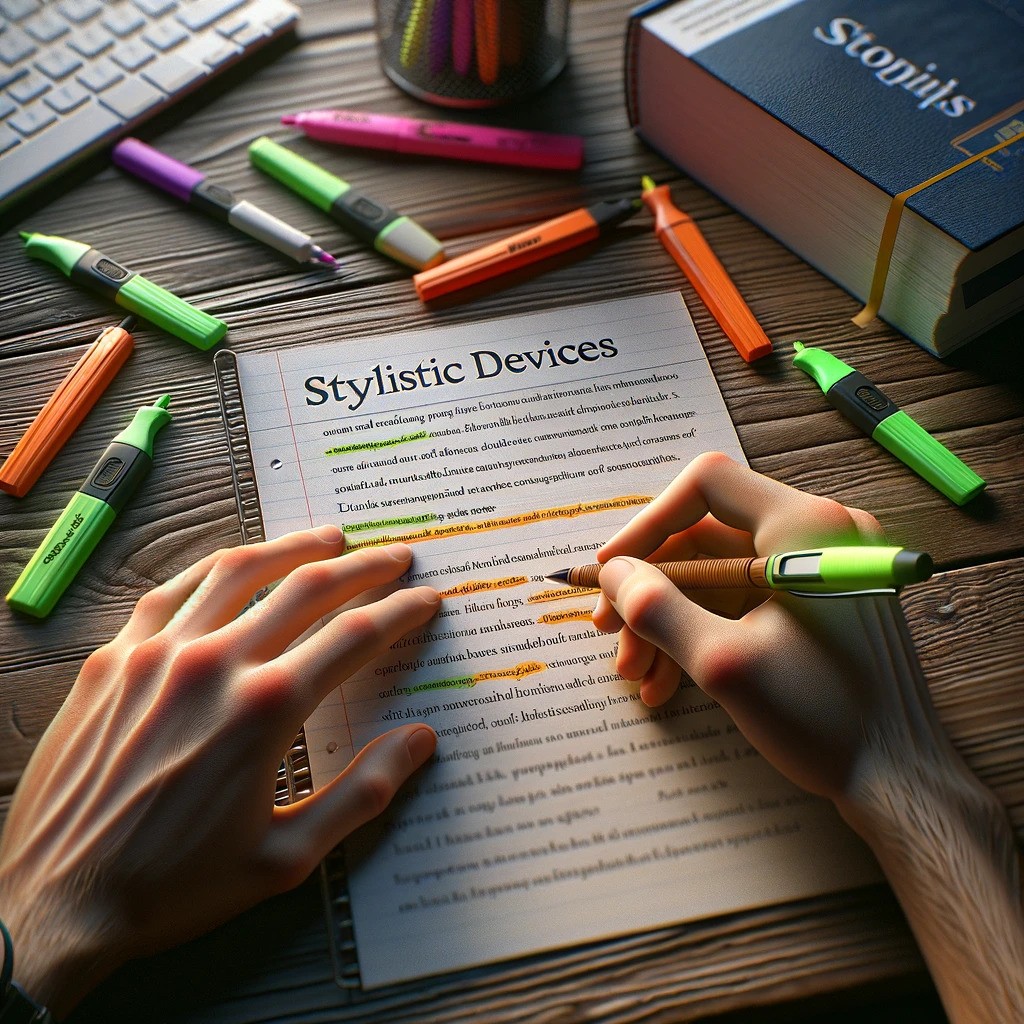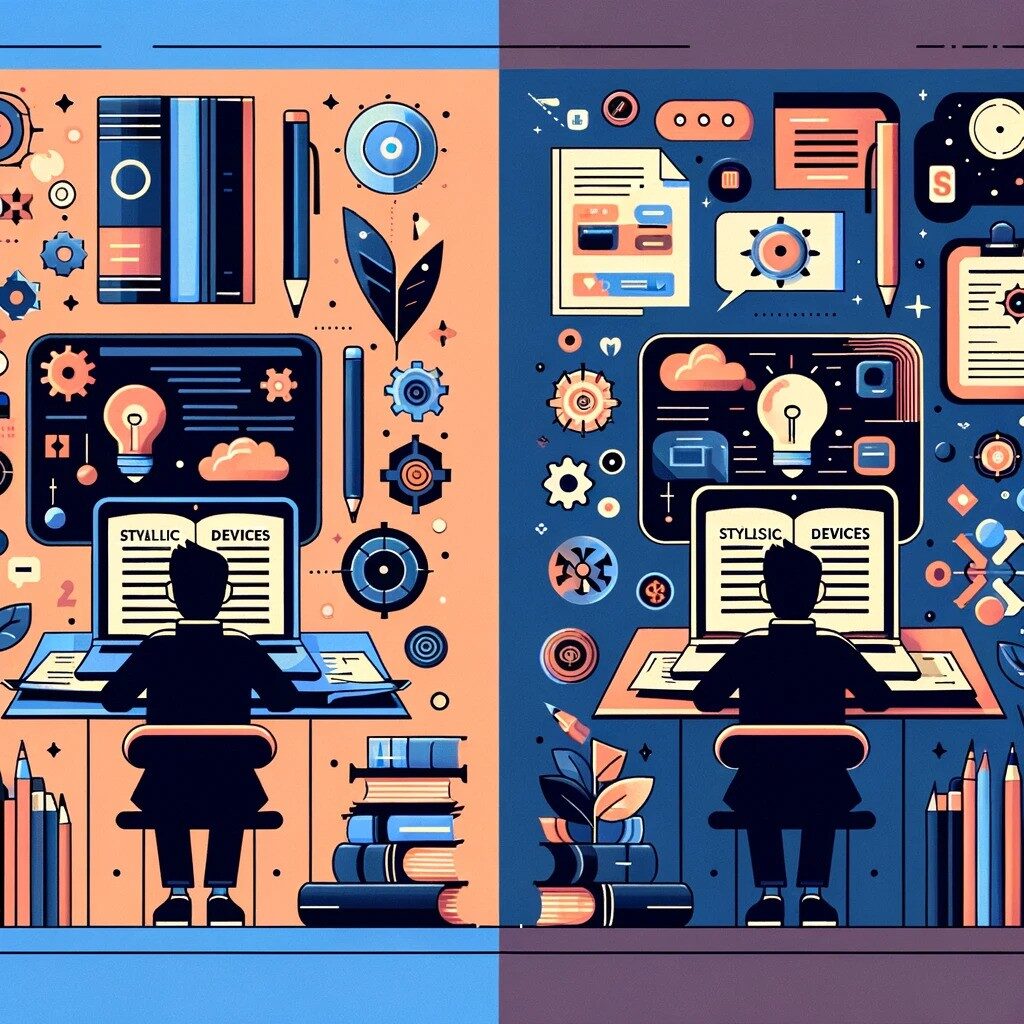
When you find a piece of writing that genuinely connects with you, it’s often because the author has cleverly used stylistic devices. These tools bring depth and appeal to their writing, making their messages resonate more deeply. Getting to know these techniques will not just enhance your enjoyment of literature but will also boost your writing skills. Stylistic devices are vital if you want to make your words stand out.
Are you writing an English essay? Then, you should read our guides on effective study techniques, improving business English, and the differences between American and British English.
Boost Your Writing and Reading with Stylistic Devices
Recognizing and applying stylistic devices can significantly improve how you understand texts and how effectively you can communicate your ideas. Engaging with the classics and your creative efforts becomes more rewarding as you learn to employ these devices. They offer a way to see beyond the surface of texts, allowing for a richer appreciation of language’s subtleties and the ability to convey your thoughts more clearly and powerfully.
What are Stylistic Devices?
Stylistic devices are strategies writers use to convey their thoughts and connect with readers more effectively. They range from metaphors and similes, which draw rich comparisons, to alliteration and assonance, adding a musical quality to their writing. It’s about choosing the perfect word, crafting a memorable sentence, or using a striking image to communicate more powerfully.
Stylistic devices play a significant role in making language beautiful and practical. They empower writers to experiment with words, lifting their work from simple messaging to an art form. By getting to grips with stylistic devices, you can appreciate the skill behind beloved works and learn how to weave these techniques into your writing. This insight does more than make you a keen reader; it transforms you into a writer capable of crafting engaging and expressive prose, ensuring your voice stands out in the vast world of language and literature.
Types of Stylistic Devices
Stylistic Devices: Metaphor and Simile Explained
Metaphors and similes are potent tools for drawing vivid comparisons, each in its own unique way. A metaphor forges a direct comparison, presenting one thing as another to deepen the reader’s grasp of a subject or emotion. For instance, declaring “Time is a thief” subtly conveys how time takes away our moments, likening its passage to the stealthy actions of a thief. This metaphor offers a rich understanding of time’s impact without a direct explanation.
On the other hand, a simile compares two things using words like “like” or “as,” creating vivid mental pictures and suggesting similarities. This device describes and invites readers to feel and visualize the comparison being made, enhancing the emotional and imaginative engagement with the text.
Example of Metaphor: “Time is a thief” — implies time stealthily takes away our precious moments.
Example of Simile: “Her smile was as bright as the sun” — conveys the warmth and brightness of her smile, enriching the description with emotional warmth.
Both metaphors and similes add depth to writing, allowing readers to explore concepts and emotions more intensely than literal language often can. They invite readers into a more imaginative engagement with the text, making descriptions more vivid and impactful.
Stylistic Devices in Action: Alliteration and Assonance
Alliteration and assonance are stylistic devices that rely on the repetition of sounds to create musicality and rhythm in writing. Alliteration features the recurrence of initial consonant sounds across a sequence of words, turning phrases memorable and engaging to the ear. Assonance, the repetition of vowel sounds within closely placed words, creates internal rhyming that adds a lyrical quality to the text, enhancing the reading experience by adding beauty and mood to the message.
Example of Alliteration: “She sells seashells by the seashore” — the repeating ‘s’ sound makes the phrase catchy and rhythmic.
Example of Assonance: “The early bird catches the worm” — the repetition of the ‘e’ sound in “early” and “bird,” and the ‘a’ sound in “catches” and “worm” enriches the phrase with a musical rhythm.
Both alliteration and assonance contribute to the richness of language, making it more captivating and enjoyable to read or hear. They play a significant role in emphasizing text sections, setting the mood, and often influencing the overall tone of a piece, whether it be playful, serious, or contemplative.
Enhancing Narratives with Stylistic Devices: Hyperbole and Understatement
Hyperbole and understatement are stylistic devices that modify the reader’s perception through exaggeration or minimization. Hyperbole amplifies a situation for emphasis or humor, making the description more vivid and emotionally engaging. For example, saying, “I’m so hungry I could eat a horse,” exaggerates to express extreme hunger, enhancing the emotional weight of the statement without literal intent. In contrast, understatement reduces an event’s apparent significance, often injecting humor or irony, as in downplaying a severe injury by calling it “just a scratch.” This contrast can also intensify the drama, encouraging readers to recognize the severity beneath the surface.
Example of Hyperbole: “I’m so hungry I could eat a horse” — exaggerates extreme hunger.
Example of Understatement: “It’s just a scratch” — minimizes the seriousness of an injury, often adding a layer of humor or irony.
Both stylistic devices play with the reader’s expectations and emotions, adding layers of meaning that enhance the storytelling or the articulation of thoughts and feelings.
Bringing Texts to Life: Personification and Anthropomorphism
Personification and anthropomorphism bring life to the inanimate or non-human, enhancing narrative relatability and emotional depth. Personification assigns human traits to non-human elements, such as animals or objects, enriching the text with qualities that resonate personally. “The wind whispered through the trees” personifies the wind, suggesting a gentle, secretive movement reminiscent of human whispering. Anthropomorphism furthers this, imbuing animals, gods, or objects with human characteristics, behaviors, or motivations, often found in children’s literature and animation. This approach entertains and facilitates the exploration of complex themes engagingly.
Example of Personification: “The wind whispered through the trees” — gives human qualities to the wind, implying a soft and secretive action.
Example of Anthropomorphism: “The cunning fox outwitted the crow” — attributes human-like cunningness and strategy to animals, enriching the story with human behaviors and motives.
Both personification and anthropomorphism draw readers into the narrative, making the experience more immersive and emotionally resonant. They allow writers to explore and communicate themes and emotions dynamically and creatively, further showcasing the power of language and imagination.
How to write an essay in English? Start with reading our top guides: Common grammar mistakes, mastering relative clauses, and state vs. dynamic verbs.
Advanced Stylistic Devices: Enriching Language and Literature
Metonymy and Synecdoche for Effective Writing
You’ll find these devices streamline your expression. With metonymy, you replace an object with something closely related, making your descriptions more efficient. Synecdoche allows you to use a part to represent the whole, simplifying complex ideas while preserving their core.
Metonymy Example: When you say, ‘The White House issued a statement,’ you’re substituting the U.S. executive administration with its iconic building, optimizing communication.
Synecdoche Example: Saying ‘All hands on deck’ means using ‘hands’ to represent the whole crew, making your call to action brief and comprehensive.
Exploring Oxymoron and Hyperbole with Stylistic Devices
An oxymoron lets you place two opposite ideas side by side to highlight contrasts or discover new insights. Hyperbole, meanwhile, amplifies your concept with exaggeration, adding either drama or humor to underline your point.
Oxymoron Example: ‘Deafening silence’ puts contradictory terms together, emphasizing the intensity of quietness.
Hyperbole Example: Telling someone ‘I’ve told you a million times’ exaggerates to vividly express your frustration or insistence.
Onomatopoeia and Apostrophe for Auditory Imagery and Dramatic Appeal
Onomatopoeia introduces sound effects into your writing, making your descriptions more vivid and engaging. Apostrophe breaks the flow to directly address someone or something not present, deepening the emotional or dramatic impact.
Onomatopoeia Example: Words like ‘buzz’ mimic bees’ sound, pulling readers into the scene with auditory imagery.
Apostrophe Example: Using ‘O Death, where is thy sting?’ speaks directly to death as if it were present, inviting readers to deeper reflection.
Engaging Readers: Rhetorical Question and Periphrasis
A rhetorical question encourages readers to think deeper without expecting an answer, often emphasizing a theme or point. Periphrasis circles around a direct statement, making your message more exciting or adding a layer of meaning.
Rhetorical Question Example: Asking, ‘Is the pope Catholic?’ drives home the obviousness of your statement.
Periphrasis Example: Saying ‘He’s not the sharpest tool in the shed’ instead of ‘He’s not smart’ adds nuance and sometimes softens the criticism.
Innovation in Language: The Role of Repetition and Neologism
Using a word or phrase repeatedly strengthens your message and makes it more memorable. Introducing neologisms, or new expressions, refreshes the language with innovative ideas.
Repetition Example: Repeating ‘I have a dream’ in a speech underlines a vision for equality and freedom, making it unforgettable.
Neologism Example: ‘Googling’ for something on the Internet introduces a new term, expanding our vocabulary with fresh concepts.
Each of these examples demonstrates how, by incorporating stylistic devices, you can make your writing more engaging and impactful, ensuring your voice is heard and felt.
Using Stylistic Devices Effectively
Understanding stylistic devices isn’t just academic; it’s a practical skill that enhances writing and reading. Here’s how you can use them to your advantage:
For Writers: Enhancing Your Prose with Stylistic Devices
- Start Simple: Ensure your core message is clear. Begin with straightforward sentences before adding complexity.
- Balance Sentence Lengths: Use short and long sentences to maintain interest. Short sentences deliver impact; longer ones add nuance.
- Use Sparingly: Devices are like spices; too much can overwhelm. Aim for balance to keep your writing engaging.
- Consider Your Audience: Choose devices that fit your readers. Avoid complexity that could alienate or confuse.
- Revise Thoughtfully: Always review your work. Look for opportunities to enrich your writing with appropriate stylistic devices.
For Readers: Deepening Comprehension with Stylistic Devices
- Engage Actively: Spot the stylistic device used, which will enhance your understanding and appreciation of the craft.
- Assess Impact: Reflect on why an author used a particular device and its effect on your reading experience.
- Inspire Your Writing: Let stylistic devices used in your reading improve your writing.
By integrating stylistic devices thoughtfully, writers can create richer, more compelling texts. Readers gain a richer engagement with texts. The key is balance: knowing when and how to use these devices to communicate more powerfully without sacrificing clarity.
If you’re seeking a tutor to help you master a stylistic device, a quick search for “essay writing tutor London” or “English tutor London” on platforms like meet’n’learn can connect you with the ideal private teacher.
For those who thrive in group settings, “stylistic device lessons Edinburgh” or “writing courses Leeds” will reveal nearby classes and educational centers focused on enhancing your writing skills.
Impact of Stylistic Devices on Reader Experience
Stylistic devices are more than embellishments. They fundamentally change how we experience a story, pulling us into the author’s crafted world where intense feelings and thoughts take flight. Here’s a closer look at their influence:
- Visuals & Feelings: Similes and metaphors pull you into the scene. Example: “The lake was a mirror, reflecting the sky’s mood” makes you see and feel the setting vividly.
- Connections: Personification makes the non-living relatable. “The city sleeps” lets you feel a quiet connection with an urban environment.
- Rhythm: Alliteration and assonance add a beat to the text. “The light of the fire is a sight to see” engages your senses, enhancing memory.
- Understanding: Irony and hyperbole encourage more profound thought. “He was so busy; he met himself coming back,” humorously prompts reflection on life’s pace.
- Imagination: These devices make you an active participant, not just a reader. You’re interpreting and connecting, making the experience personal.
Stylistic devices do more than narrate; they enrich your reading journey, making it more profound and memorable. As you explore and appreciate these tools, you discover new layers of meaning, enhancing your enjoyment and understanding of the text. For writers, knowing how to use these devices means you can craft stories that resonate deeply with readers, making every word count.
Boost Your Reading and Writing with Stylistic Devices
Stylistic devices play a crucial role in writing and reading, offering ways to make language more impactful and engaging. Understanding these tools is key for anyone looking to improve their communication skills. Whether through self-study or with the help of a tutor, learning about these devices can significantly enhance how you express ideas and understand others’ writing.
Tutors and private teachers can offer focused lessons on these concepts, providing personalized feedback and strategies to integrate stylistic devices effectively into your writing. This tailored approach can be beneficial, making complex ideas more accessible and learning more efficient.
As you continue to explore and apply stylistic devices, your appreciation for the written word deepens, alongside your ability to convey thoughts and emotions more precisely. It’s a journey worth taking, promising richer experiences with every step.
Are you interested in other subjects? Read top free study guides for Biology, Chemistry, English, French, and Music.
References:
1. Studio Binder
2. Wikipedia
3. Semantix



